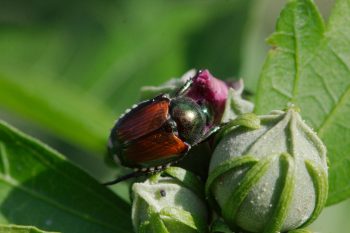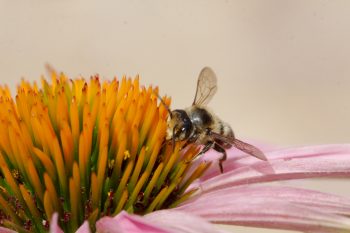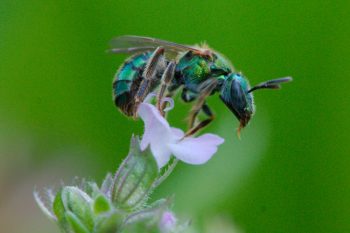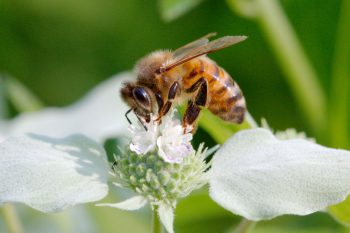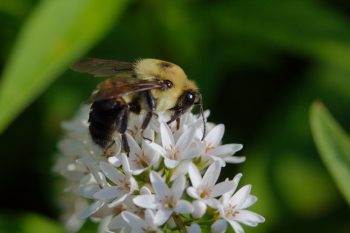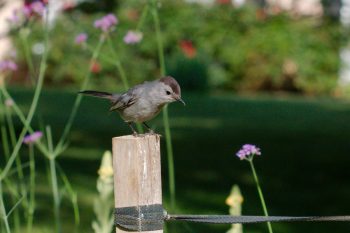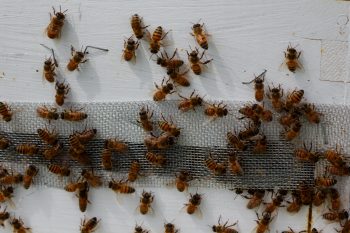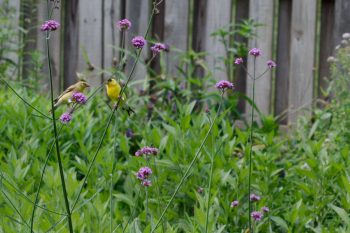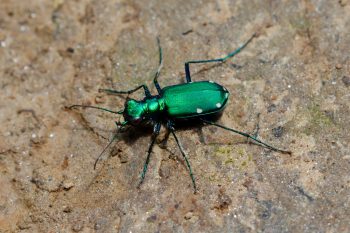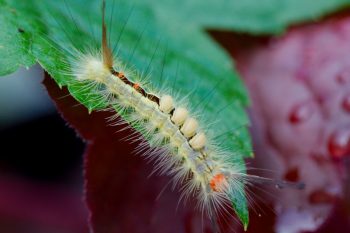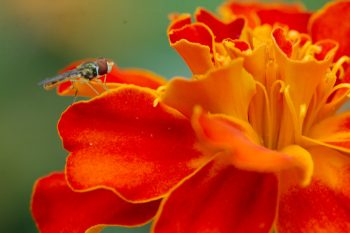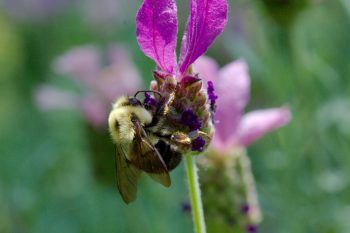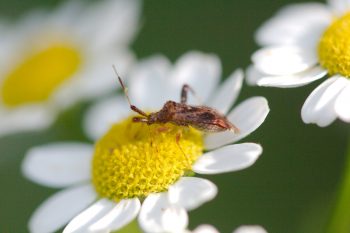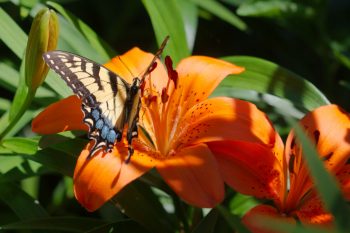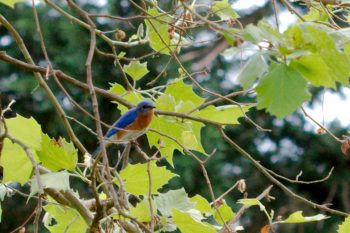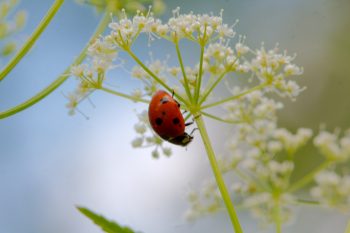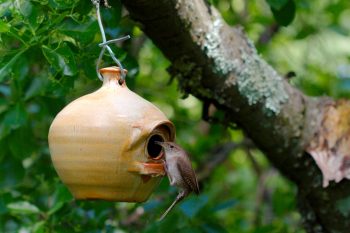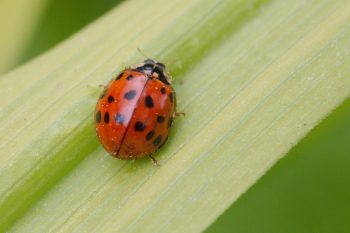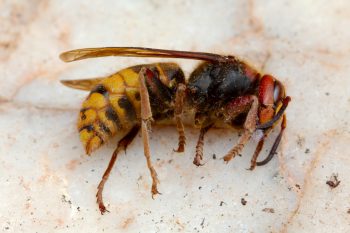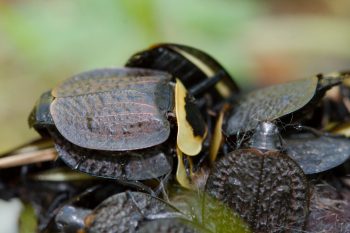I am definitely not a fan of the Japanese beetle (Popillia japonica), a native of (unsurprisingly) Japan, and instroduced into North America in the early 20th century (first found in the United States in 1916 near Riverton, New Jersey). They are quite destructive of a wide variety of plants, including both ornamental plants (like roses, which they love) and agricultural crops (soybeans, stone fruits, etc.). Their larvae damage lawns, feeding on the roots of grasses. They are, of course, pretty if you can disassociate them from the destruction they cause. But that’s hard for me to do and I don’t really have a lot of sympathy for them. This one is on a rose of Sharon (a.k.a. shrub althea, Hibiscus syriacus).
Creatures
Popillia japonica (Japanese Beetle)
Resin Bee on Coneflower
I wasn’t happy with most of the pictures I took today, but this one isn’t too bad. I’m pretty sure this is a sculptured resin bee (Megachile sculpturalis), although there are a few other Megachile species it could be (e.g. the flat-tailed leaf-cutter bee, Megachile mendica, which is more common). Regardless, it’s a nice, quiet little bee and it was moving among the coneflowers, along with a few other solitary bees and an occasional honey bee (Apis mellifera). I know that some folks are not fond of bees and don’t like to have them around. With the exception of a few aggressive hornets and wasps, I like having them around. They really rarely sting unless provoked and they are quite pretty to watch on flowers.
Green-Sweat Bee
I was out with my macro on a 25mm extension tube this evening and got a few decent photos of this green bee. I labeled it a cuckoo wasp at first, but now I’m thinking it’s a green-sweat bee (Tribe Augochlorini). But don’t hold me to that. If I get a better identification, I’ll update this post. For now, all I can say for sure is that it’s a bee (Anthophila). I can also say that it’s quite pretty. It was moving around quit a bit and this was the best I could do at ISO 800, f/8, 1/100 second.
Honey Bee (Apis mellifera)
The mountain mint (Pycnanthemum muticum) is starting to bloom. I won’t claim it’s a hive of activity yet, but there’s certainly a bit of a buzz. Mostly I’m seeing honey bees (Apis mellifera) on them so far, but the mountain mint is very attractive to a wide variety of insect life from small beetles and bugs to bees and wasps, and some butterflies. The buddleia next to this tends to get more butterflies, though. It loves the sun and the insects are out in the most fierce in the heat of the day. Not my favorite time to sit there with my camera but it’s sometimes worth the effort.
Common Eastern Bumble Bee (Bombus impatiens)
Pretty much all the flowers in our garden are attractive to insects. I suppose that makes sense, because that’s what flowers are supposed to do, in order to get the insects to (inadvertently) pollinate the flowers. It’s interesting to me, though, that some flowers are attractive to many different insects but some seem to attract a specific subset. Yesterday, I was looking at the Monarda (bee balm) and noticed that the large bees were almost exclusively carpenter bees (Xylocopa virginica). Today I was looking at the gooseneck loosestrife (Lysimachia clethroides) shown here and the large bees were exclusively common eastern bumble bees (Bombus impatiens). Just interesting, that’s all.
On a mostly unrelated note, I really, really don’t recommend you plant any Lysimachia species in your garden. The bees love it, but there are other things they like that aren’t so overwhelming.
Gray Catbird (Dumetella carolinensis)
After work, except on days when it’s raining, I’ve been trying to sit in the yard to read. It’s started to get warm lately but I’ve still gone out, sitting in the shade after 5:00 PM, when it’s not quite so bad. I take my camera with me and look around for something to photograph. While I was reading, this gray catbird (Dumetella carolinensis) came and sat on the stake holding up our new hawthorn tree. It looked around for a little while and then flew off. There are quite a few of them around and since they are insect eaters, I’m quite happy to have them.
Western Honey Bees (Apis mellifera)
We took a drive to Lewis Orchard to buy peaches today. It was very hot and being out in the sun with masks on was not really all that nice but we managed and bought enough to make a cobbler and have plenty left over to eat simply cut up with whipped cream. From there we stopped at our friends’ farm. The last time we were there Greg said I should stop to see the bees but we left the other direction so didn’t. This time we stopped and I got a few pictures of the honey bees (Apis mellifera). I also happened to get stung on my nasal septum, which wasn’t the most fun, but a honey bee sting is, thankfully, not that bad.
American Goldfinches (Spinus tristis)
There are some birds, notably the American robin (Turdus migratorius), that doesn’t really compare favorably with its European counterpart (Erithacus rubecula. While the European goldfinch (Carduelis carduelis) is a lovely bird, I think our American Goldfinch (Spinus tristis) is quite beautiful. This is a female (on the left) and male (on the right). They really love the Verbena bonariensis and it’s fun to watch them as they land and the stems bend under their tremendous weight. I enjoyed this couple for quite a while this morning.
Cicindela sexguttata (Six-spotted Tiger Beetle)
Cathy and I went on a new trail today. I don’t know if the trail is actually new but it was new to us. We walked in the Rock Creek valley between Muncaster and Muncaster Mill Roads. As the crow flies, it’s probably a mile from end to end. The trail winds quite a bit and there’s a bit of up and down and based on a map we found, it’s more like 2.5 each way. So, about five miles. It was pretty hot and very humid, but we really enjoyed the green and also the birds that were supplying the background chorus most of the way. We saw quite a few of these six-spotted tiger beetles (Cicindela sexguttata) as well as ebony jewelwings (Calopteryx maculata), a damselfly with black wings (except for on females there is a conspicuous white spot at the end of the wings.
White-marked Tussock Moth (Orgyia leucostigma)
I was sitting outside this morning, taking a break from doing some yard work, when I noticed this caterpillar on the tire of my car. I moved it to a plant, figuring it would be shown to better effect there than on the black tire, and then I got my camera and took a few photos. It is a white-marked tussock moth (Orgyia leucostigma), a species native to our region. Interestingly, the adult females are wingless and therefore flightless. If you find one of these, you’ll want to avoid handling it with your bare hands. Its hair is known to cause allergic reactions, especially in areas of the body with sensitive skin. I let it crawl onto a leaf to move it, so as to avoid any issues.
Syrphid Fly on Marigold
I went out to take some pictures of flowers today. There are a few sitting on a table that I set up for Cathy to work on and that seemed like a nice place to sit and take pictures. I took some of a coral bells plant (Heuchera x ‘Blondie’) and then I noticed this syrphid file (Family Syrphidae) on a marigold blossom. There’s only so close I can get with my 100mm macro and I’d like some way to get closer. I’ve thought about buying a Canon MP-E 65mm f/2.8 lens that gives magnifications of 1 to 5 times, basically picking up where my current lens leaves off. It’s manual focus, but at that close range, focus is as much a matter of moving the camera closer or further away from the subject.
Bumble Bee on Lavender
I sat in the middle of the front garden this afternoon and took a few pictures. There were some bumble bees (Bombus impatiens, the common eastern bumble bee) moving from flower to flower and I waited for one to land on the lavender (this is a variety of Spanish lavender, Lavandula stoechas called ‘Anouk Supreme’). I only got four photos and none of them are quite what I was hoping for but this one isn’t too bad. When I’m in the yard, especially when it’s hot, I generally favor the shade but if I’m looking for photos, especially insect photos, the sun is the place to be.
Plant Bug on Feverfew
I was taking pictures of the feverfew (Tanacetum parthenium) growing in the back of our garden when I happened to notice this little plant bug. I don’t know what type it is and I’m not sure the photos I got are good enough for more than a general identification, so I’ll just leave it as a plant bug (Family Miridae). We’re in the in-between phase when there are fewer things in bloom. The flush of spring ephemerals is well past and most of them have already lost their leaves for the summer. The roses have finished their first flush but those that repeat will be with us off an on all summer. The Asiatic lilies and a few smaller things are the only sources of blooms right now. I’m not complaining, mind you, just saying.
Tiger Swallowtail (Papilio glaucus)
We had our first sighting of a tiger swallowtail (Papilio glaucus) today and it was nice enough to perch on the Asiatic lilies growing in our front garden. I’ve actually seen a few butterflies around but haven’t had a chance to get any photos. Soon we’ll have them in abundance, especially when the Buddleia starts to bloom. These Asiatic lilies are surrounded by tiger lily plants (Lilium lancifolium), which are considerably taller and I’m not sure these can get the attention they deserve. On the other hand, this makes them harder for the deer to get to, which is a plus.
Eastern Bluebird (Sialia sialis)
Cathy and I took a walk in the neighborhood this evening. It was quite warm and humid but it’s still good to get out from time to time. I took some pictures of a purple clematis on a mailbox that turned out pretty well but I thought I’d share this photo of an eastern bluebird (Sialia sialis). It’s not as sharp as I’d like, but all things considered, it’s not too bad. These can be seen year round in our area and it’s always a treat. Maybe we’ll put up a bluebird box in the yard next year. It would be wonderful to have them in the yard.
Asian Lady Beetle (Harmonia axyridis)
I took some photos of some yellow flowering sedum this afternoon but they didn’t turn out very well. You’d be stuck with them except I happened to see this Asian lady beetle (Harmonia axyridis) on a stem and got down on the ground to get a few photos of it. This plant has a flower cluster similar to Queen Anne’s lace but that’s not what it is. It’s a very aggressive weed that we picked up somewhere along the way and we really need to do something about it. But it made for a nice photograph, in this case. It may be Chaerophyllum aromaticum but I really don’t know. Whatever it is, you really don’t want any.
House Wren (Troglodytes aedon)
I was out front sitting in a lawn chair taking photos of the spiderword (Tradescantia virginiana) when one of our house wrens flew up and landed briefly in the small apple tree growing near by. Then it flew to the nesting box (for lack of a better term—it’s a ceramic bottle, basically) and posed for me before disappearing inside. The other was around, as well, singing up a storm. These are very vocal little birds with a lot of volume relative to their size and we love having them. They are a lot easier to hear than to see, as small as they are.
Lady Beetle
I haven’t included the specific name for this lady beetle in my title because I’m not entirely sure what it is. My guess would be that it’s an Asian lady beetle (Harmonia axyridis), though as they are quite common and this certainly looks right. But I’m no expert. I got one photo of this on a leaf before it flew away so although it isn’t as sharp a picture as I’d like, it’s all I have. These are, of course, insects that we like to have in our garden, as they eat aphids. I haven’t seen aphids in great numbers in the garden yet this year but they’ll be along before too long, have no fear. That and Japanese beetles are the two insect pests I see the most in the summer months.
Vespa crabro (European Hornet)
This is a European hornet (Vespa crabro). It’s also dead. I found it on the floor of the basement when I stepped on it in my bare feet, which worried me a little. It was mostly dead before I stepped on it and completely dead after that. Since I didn’t get stung, I’m over it. They are predatory on other insects so in general (and outside my basement), I have no problem with them being around. They are similar in size to the eastern cicada killer (Sphecius speciosus) but are quite different in appearance. As large as they are, the European hornet is smaller than the Asian giant hornet (Vespa mandarinia, sometimes referred to as murder hornets), which can be 30% to 50% larger.
Necrophila americana (American Carrion Beetle)
We took a walk near Lake Frank today and had a really nice time. We saw one adult and one juvenile bald eagle next to and on the nest across the lake. It’s too far, really, to get a good picture but I did take a few, anyway, just to record the fact. We happened to come across this pile of American carrion beetles (Necrophila americana), presumably on a piece of carrion. They were definitely there for a reason. It’s fine to get grossed out by them, but then, without them, the rotting meat would stick around a lot longer, so in my book, they’re doing us a service.

